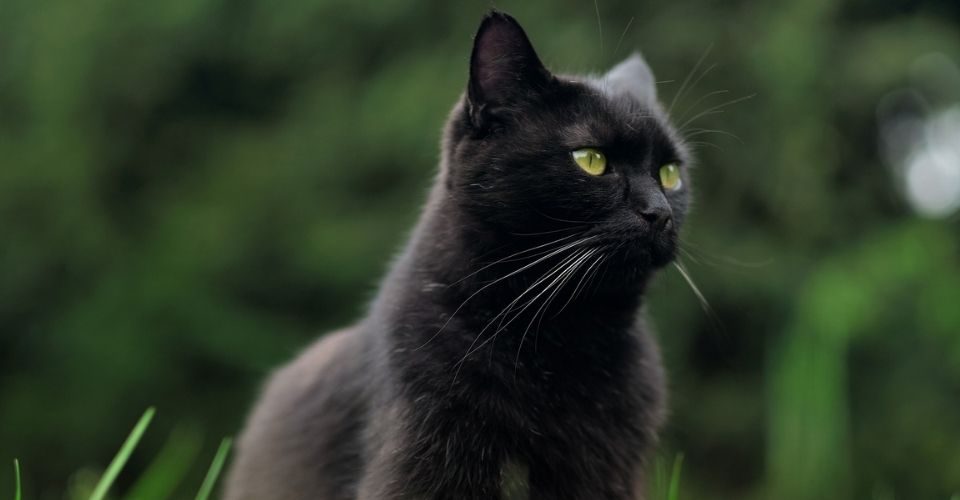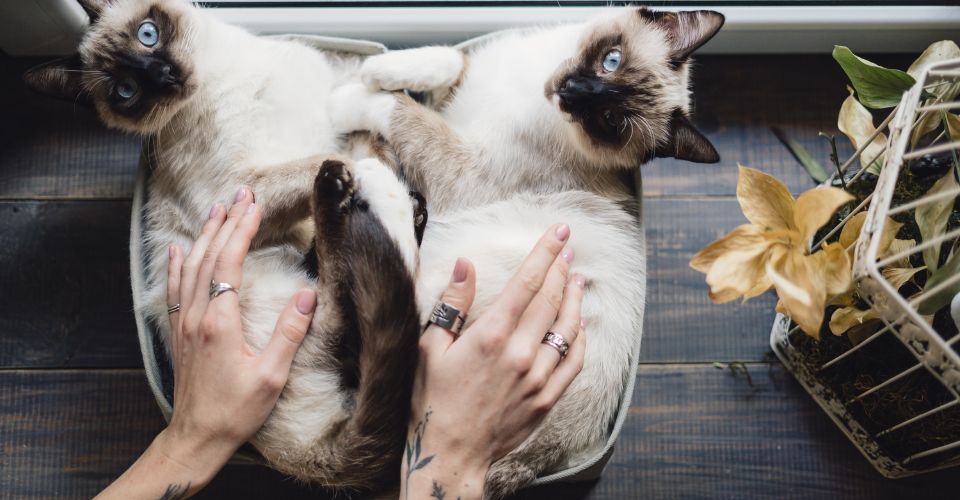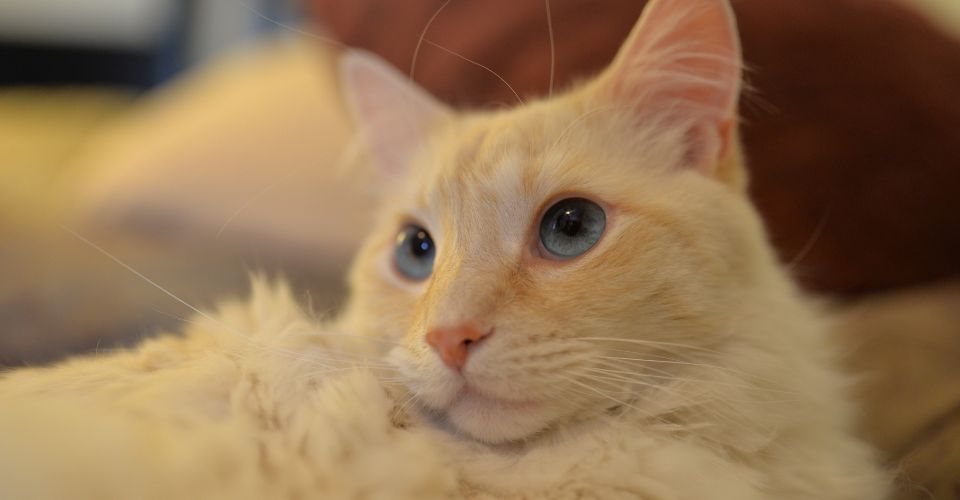Havana Brown is a widely sought-after and rare cat breed. They are medium-sized cats covered in rich brown color with Venetian red undertones. They have bright green eyes, glossy short to medium-length coats, and distinct muzzle shapes. One of their most distinguishing features is their head shape—it’s longer than wide.
Havana Browns’ charming personality attracts the attention of every cat lover. Unique triangular head shape and mesmerizing eyes aren’t the only things Havana Browns are known for; their high intelligence and adaptable nature are what fascinate feline enthusiasts the most. They happily thrive with children, strangers, and even dogs.
Having a playful and talkative personality but can be a bit loner sometimes. Havana loves to be around human companions, fancies playing fetching games, develop a strong bond with their loved ones and follow them around the house like a puppy. They are often called puppies of the cat world.
From origin to best brush size for Havana, this blog contains everything you need to know about this unique Brown cat breed. But first, let’s take a quick look at the Havana Brown cat breed overview.
Havana Brown Cat Breed
Havana Brown Cat Breed Overview
Weight: 6 to 12 pounds
Height: 9 t0 11 inches
Lifespan: 8 to 15 years
Eye color: Green
Coat color: Red-brown rather than black-brown
Temperament: Playful, affectionate, sensitive, friendly
Suitable for: Brown cat lovers, families with children, families with other pets
History
Planned breeding between Siamese cats and black Domestic Shorthaired cats was carried out by cat fanciers in England, in the 1950s, in order to produce a self-brown cat with emerald eyes. As a result, the first kitten born was named the Elmtower Bronze Idol, which was the foundation cat for the new breed.
The breeding continued in the United Kingdom and was called Chestnut Brown Oriental. The breed took a different turn when two kittens were exported to the United States in the 1950s. In the U.S., they are known as “Havana Brown” and have a different body and head shape as compared to the ones in the U.K. The breed was also nicknamed “Swiss Mountain Cat” when it first arrived in England.
It is believed that Havana Browns are named after the color of Havana cigars due to their matt appearance or Havana rabbits of the same color. Some historians also believed it was accidental breeding, yet the history is still a bit cloudy.
Havana Browns are the rarest cat breed, with only fewer than 1,000 left in the world. Since the breeding pool is small, Havana is considered to be an endangered breed. Efforts are being made to save the Browns from extinction.
Personality and Temperament

Often called ‘Chocolate delights’ by cat fanciers, Havana is a charming, captivating, curious, gentle, and smart cat. They crave human interaction and often gently extend their paws to human companions that appear out to be holding a paw of friendship. They often become attached to one person and may exhibit clingy behavior—following their favorite person around the house. They may often hop into your lap, and sometimes you may wake up to your Havana Brown cat lying on top of your chest.
They have a soft voice and may often purr to communicate with their owners. They want your undivided attention and may purr, nudge you or hop into your lap until they have it. They will perch on your shoulder and will rarely leave your side.
Havana exhibits power yet gracefulness and elegance. They are playful and extremely sensitive cats that go very well with children, other cats, and dogs. With high intelligence, Havana needs daily physical activities to avoid boredom and to keep herself happy. Havana loves to play with interactive cat toys and fetching games. A cat laser toy can easily capture their attention and keep them engaged for hours.
Appearance
Havana is unique for its distinct head shape—it is longer than wide. They have rich brown skin with mahogany undertones, a firm, and muscular body, bewitching green eyes.
They have large round-tipped ears, forwardly tilted, which gives them an alert appearance. They are the only cat breed with brown whiskers, complementing the body color. Browns have slender legs, a medium-length tail, and an overall height of 9 to 11 inches. Males are comparably larger than females. They have a small leather brown nose with rose blush. On the chin at the lower lip, Havana has sparse hair, which is a unique feature of this breed
Coat
They have a short to medium-length glossy coat with a very soft texture and no tabby markings. Also, keep in mind that some kittens may show markings, but they dissolve as they mature. The brown coat ascents towards red-brown rather than black-brown. The coat offers a feeling of a luxurious fur coat.
According to The International Cat Association (TICA), the Havana Brown can also come in lilac; thus, they changed their name from Havana Brown to Havana.
Legs and Paws
Their hind legs are longer than the forelegs. Females have slim and proportionally slender legs than mature muscled males. Their paws are tamped and oval, and toe beans are blush-toned.
Havana Brown Cat Care
Havana Brown is a low-maintenance cat breed and does not have any special care needs.
Feeding
Havana Brown breed needs nutritional food and a high-quality diet. Protein must be the key ingredient in the diet. High-quality dry cat food is a popular choice among feline lovers. Place the bowl in the room where your cat stays the most. If she eats her meal in one sitting, then fill only ¼ of the bowl. Havana Browns are prone to obesity, so keep a close eye on your cat’s diet. Also, make sure fresh and clean water is filled in the bowl all the time. Many veterinarians recommend wet food to provide moisture to cats, especially when the cat is not drinking water.
If you notice your cat’s appetite being too little or too much, visit your cat’s veterinarian immediately.
Grooming
As mentioned, Havana Brown cat is a low-maintenance cat breed, not needing much grooming. But here is how what you will need to do to keep your cat happy and healthy.
- While bathing is rarely necessary, you should brush your cat coat at least once a week.
- The weekly brushing removes the loose hair and dirt from the skin. After brushing, wipe her with a chamois or silk cloth.
- This will not only maintain the glossy look of her coat but will also strengthen your bond.
- You should also trim your cat’s nails regularly as overgrown nails can be hurtful to them and bad for your furniture.
- Havana Brown cats are prone to gingivitis; thus, you will have to brush their teeth daily to maintain their dental health.
- You should also check your cat’s ear every now and then to look for signs of an ear infection (we hope you find none).
- Each eye should be cleaned with different wipes to prevent eye infections contaminating both eyes.
- Havana Browns have a short-haired coat and are sensitive to temperature and thus should not be kept outside for long times, especially when the sun is out.
Training
Havana Brown doesn’t like to be trained harshly but only with playful and affectionate nature. They do well with a handful of cat treats and a clicker. Havana is a smart cat with high intelligence and adapting qualities.
Litter box training should be done when your kitten is about one month old. Some cats may not need to be trained and will instinctively use a litter box, while others would require some training.
Exercise
Havana Brown is a moderately active cat, but they will never get tired of tailing you around the house and helping you in your household chores. They crave human interaction and love to become a part of your daily activities. They even enjoy playing fetching games, which is not rare but unusual for cats.
If you don’t want your cat to invade your personal space and leave you alone, or you don’t have free time to play interactive games with your cat, you should reconsider adopting a Havana Brown cat.
Common Health Issues
Havana is an overall healthy cat breed. That said, the breed is prone to the following health issues:
Ringworm
Circular areas of hair loss, bald patches, or broken hairs are the symptoms of ringworm in cats. In 98% of cats, ringworm is caused by a fungus called dermatophyte. It also spreads from cats to humans.
Calcium Oxalate Bladder Stone
Cats have a high level of calcium and oxalate in urine due to high blood calcium levels or a low urine pH (acidic urine). When in large amount, it can create problems. Diet or environmental conditions can also be the reason for bladder stones, or it can be genetic.
Allergies
Havana Browns are prone to different skin allergies. The symptoms include excess scratching or licking.
Diabetes
Too much sweet can be a problem for cats as for humans. The main reason for diabetes in cats is obesity. In Havanas, however, diabetes can be genetic. So, no matter what, most likely, your Havana brown cat will become diabetic if you are a bit careless with her diet. Your vet may detect diabetes by running a diabetic test on your cat.
Four Reasons Why You Should Get a Havana Brown Cat?
Easy to Groom
Havana Browns do not shed much and are easy to groom. Weekly brushing, nail trimming, and ear cleaning are all they need for grooming.
Social Cats
They get along well with children, dogs, and other cats. They crave human attention and become very attached to the owners. They love spending time with human companions and might follow you wherever you go.
Playful Nature
Most Havana Browns are outgoing and playful. They are moderately active as compared to other shorthair breeds and are content in playing with their favorite toy. They often play fetching games as well.
Rare Cats
Solid brown cat breeds—cats with brown coat color from nose to tail—are quite rare, and among them, Havana brow is even rarer. Most people never get a chance to encounter Havana. So won’t it be cool to own a chocolate delight?
Four Reasons Why You Should Not Get a Havana Brown
Expensive Breed
Rarity means high prices! Given that Havana Brown is a rare cat breed, you should expect them to have a hefty price tag.
Obesity and Other Health Issues
Havanas are slim and muscular cats. They are prone to obesity, especially when they are not getting ample workouts. Obesity leads to other diseases such as diabetes, fatty liver, etc.
Browns are prone to various other health issues as well such as arterial thromboembolism, FLUTD, hemophilia, diabetes mellitus, allergies, or heart diseases.
You May Get Scammed
Given the rarity of Havana browns and brown cat breeds in general, many breeders are always mixing brown or black cats with other cats to produce the rare solid brown coat so they could charge cat lovers a hefty price. So chances are you may have a mixed cat breed under the label of Havana Brown.
They Need a Lot of Attention
Havana Browns establish a strong bond with their loved ones and like to tail them around the house. While it is cute, sometimes, it can be a problem—you cannot leave them home alone for a long time. If left alone, they develop separation anxiety and behavioral issues. So if you are a working parent, you should reconsider getting a Havana Brown.
Best Brush for Havana Brown
While many options are available in pet stores, for Havana Brown, soft slicker or rubber curry brush can be the best choices. This brush is suitable for all coat types. It removes loose fur and dirt without pulling your cat’s hair and untangles the knots, if any.
Do Havana Brown Shed?
Havana Browns have short hair coats and do not shed much. Thanks to their short coat, they produce less dander than other cat breeds. But still, they are not considered a hypoallergenic cat breed. If you have pet allergies, you should reconsider getting a Havana Brown cat. But if you decide to still get a Havana cat, you will have to groom them meticulously to reduce the risk of allergic reactions.
How Long Do Havana Brown Cats Live?
Havana Brown cats have an average lifespan of 8 to 15 years. That said, many factors, including diet, fitness level, genetic history, and lifestyle, are involved in determining how long you’re your cat will live. Therefore, if kept with great care, your cat may live well beyond 15 years.
Final Words
Extremely elegant yet smart and playful, this breed has made its place among the list of favorite pets. Havana Brown is a rare cat breed and loves human attention and affection. They crave human companionship and do not like to be left alone. Havana makes excellent pets and knows how to win hearts with their super cute nature and loyalty. With Havana being only less than 1,000 left all over the world, isn’t it fascinating to own a unique one?






